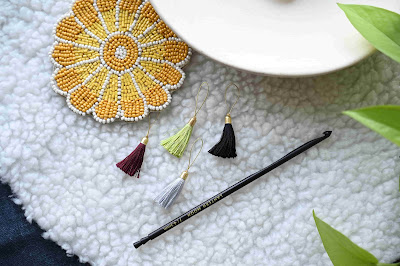How to Use Stitch Markers in Knitting
As a beginner, you may get confused with patterns and designs in your knitting project. Most knitters enjoy knitting while watching TV; during that time, you may often forget or get lost in patterns. You need a tiny but mighty tool: Stitch markers, an invaluable tool. These generally help the knitters to keep track of stitches. Whether you are making a small project or a large one, needless to say, stitch marks are essential. This guide will explore stitch markers, how to use them effectively, different types, and when to use them.
Let’s define the concept first.
What do you understand by the term Stitch markers?
It is a memory device, marker, or tool that helps you remember things. This small tool can easily identify the important location in your knitting work. These are generally a small ring or a clip that you can place on your knitting needle or within your work to indicate specific points. These small, colorful knitting accessories help you to avoid mistakes.
How many types of stitch markers are there?
These are available in various sizes, colors, materials, and shapes. Let’s check out different types of stitch markers:
-
Closed stitch marker
These are also called ring markers. They have a solid circular shape with no opening and can easily slide onto your knitting needles. These are good for marking special stitches or at the beginning of round shapes in circular needles.
-
Open or split stitch marker
These stitch markers can be opened or closed. And it is easy to attach or remove them. They are perfect for marking specific rows or stitches.
-
Locking stitch markers
These are like tiny safety pins. It is versatile and can be used directly on needles or the fabric.
Different stitch markes comparison at a glance
|
Types of stitch marker |
Pros |
Cons |
|
Closed stitch marker |
Simple to use and stays in place |
You can not remove it from the middle without slipping from the needle. |
|
Open or split stitch marker |
Easy to attach and remove |
Fall off if not secured properly. |
|
Locking stitch markers
|
Won't fall easily |
Slightly bulkier. |
We hope the concept is clear. Now, let’s move on to the next step.
When to use stitch markers?
Stitch markers are like a ‘landmark’ in your knitting project. They help you identify at which point you need to use stitch markers.
Here are some points you can consider:
- Mark at the beginning of the round
When you create a round item, you are sometimes confused about where the beginning or end is. You can place a stitch marker on the needle to indicate each round's beginning. In this way, you won't lose track.
- Tracking the repeated patterns
If your project indicates repeated patterns, you can place the marker at the beginning of each repeat; this will help you to stay on track and avoid mistakes.
- To indicate an increase or decrease
When you work on a project that needs regular increase or decrease, these stitch markers can mark where it needs changes. Then you don’t have to count it again.
- To divide sections in a project
Sometimes, in a complex project like a sweater or blanket, stitch markers can divide the different sections easily, making the patterns easy to understand.
- Knit or crochet cable stitches
Stitch markers are a life savior if you plan to knit or crochet cable patterns. You might need to repeatedly work on the same stitch until you reach that marker. Then, you must pay close attention or refer to the pattern chart.
- A color change in the pattern
Some projects require you to change the color, so many times, knitters or crocheters make mistakes. To avoid this situation, place a stitch marker at the beginning or the end of the change in color pattern.
How to place stitch markers?
It is an important question: Where should you place it? You can position them on the knitting needles before or after the specified stitch. If you use a locking or split marker, simply put them on the stitch within the fabric.
Before you go and grab your knitting accessories, let’s learn some tips:
Tips for using stitch markers
This small tool is an important part of knitting. So, you must cautiously use it without wasting time.
Here are some factors you can consider:
- Use different colored stitch markers; it will help you to recognize the other patterns, increase or decrease.
- If you lose or need an extra marker, you must carry some extra stitch markers for your project.
- Use the right size of stitch marker. It should not be too small or too large. Otherwise, it may harm your yarn.
Now, you can easily find out the importance of this tool. It helps simplify your project and stay organized. Stitch markers are handy in handling complex patterns. You can work on your project smoothly and enjoy your knitting project. So don't forget stitch markers when buying knitting needles or crochet hooks.




Comments
Post a Comment